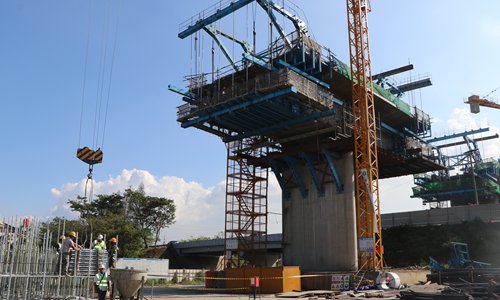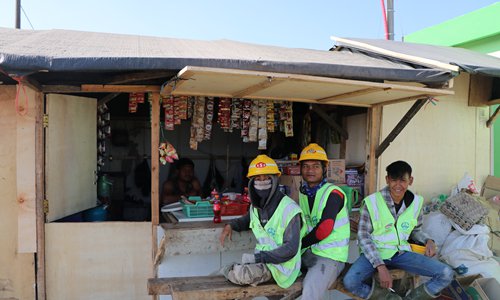Jakarta-Bandung bullet train project powers up local economy, brings technology transfers
2019-08-01 10:28:44
Summary:A prestressed concrete continuous rigid frame bridge in Bandung is being built for the high-speed rail project li...

A prestressed concrete continuous rigid frame bridge in Bandung is being built for the high-speed rail project linking Jakarta and Bandung. Photo: Li Qiaoyi/GT
In the backseat of a cab hailed from Grab, a mobile app popular among Indonesians enabling ride-hailing and food delivery services, I asked a local friend sitting next to me when the rush hour is in Jakarta, the capital city that's home to about 10 million people. She smiled, sharing a gridlocked drive in the early afternoon of a workday last week, and replied: all day long.
So it seems to me that a three-to-four hour drive between Bandung and Jakarta, one of the most populated areas in Indonesia, is nothing to complain about, although if the traffic is bad, it could take well over 10 hours. For those traveling at night on the highway between the two metropolises, vehicles equipped with restrooms would be desirable.
Still, a landmark high-speed rail project linking Jakarta and Bandung on the populous island of Java, which signals China's maiden attempt to export its high-speed rail expertise in its entirety, appears to have been tepidly received in the Southeast Asian nation where there's an apparent eagerness to embrace the mobile internet, yet people are to be motivated to jump onto high-speed trains.
Having not been to China before and without any idea of what Chinese high-speed trains look like, my friend, a white-collar worker in Jakarta, said she had heard about the high-speed railway being built in her country in the news, but didn't know how it was progressing.
Overcoming challenges
At the beginning of 2016, Indonesia broke ground on the 142.3-kilometer railway, a landmark project along the sea route of the China-proposed Belt and Road Initiative (BRI). It will cut travel time between Jakarta and Bandung to merely 40 minutes and is set to catapult Indonesia into the bullet train club, the first Southeast Asian nation to do so.
Nevertheless, it was not until May 31, 2018 that Kereta Cepat Indonesia-China (KCIC), the project consortium comprising four Indonesian companies and five Chinese companies, signed an order to officially commence the project on June 9, 2018. The Indonesian side holds a 60 percent stake in the consortium designed to build and operate the rail, while the Chinese companies own the remaining stake.
If everything goes as planned, the rail project will be completed in 36 months. That suggests the rail opening might be expected in 2021, well behind the initial schedule which envisaged the service starting in 2019.
The hold-up was largely due to the complicated and lengthy land acquisition process, according to Hu Qisheng, deputy general manger of the Jakarta-Bandung high-speed railway project of China Railway Group Limited (CREC), one of the five Chinese companies and the project's main contractor.
Behind the construction delay are discrepancies between local governments and the central government in Indonesia with regard to land acquisition and varied construction approvals, Hu told the Global Times last week in his office in Bandung.
Handover of land for the project was 76 percent of the planned level as of July 19, and demolition on a portion of the land that has been handed over is yet to be done, which has hamstrung construction, per figures provided by CREC.
The rail project is now about 25 percent done, an executive at KCIC said in an interview with the Global Times in Jakarta on July 23.
The delay, however, has barely dented the enthusiasm of both sides who are striving to get the rail project, which exemplifies China's high-speed technological prowess and highlights Chinese rail standards, back on track.
Building a high-speed railway in Indonesia, which is frequently struck by earthquakes and sometimes accompanying tsunamis and where soft soils necessitate the employment of special construction methods to avoid sinking the structure build on them, attests to China's strength in the high-speed rail arena, CREC's Hu said, vowing a continuation of efforts to push the project ahead.
In an interview with the Global Times in his office in Jakarta on July 23, Sahala Lumban Gaol, a special advisor to Indonesia's state-owned enterprises minister, said "we [are] still [running] a little behind the plan, but it's not really late."
With more progress made, especially regarding high-speed rail bridges that are more visible compared with tunnels, local people who still don't know of this project will actually see it running, he said.
In May, the 608-meter Walini tunnel in West Bandung regency was broken through, the first to be completed among the rail project's 12 tunnels.
"I feel confident working with [CREC]. They have good experts in this field, [which] gives us confidence," the special advisor said.
The technology being implemented here is Chinese technology, he said approvingly, extending his gratitude to Chinese companies' efforts to help train local engineers and workers, imparting technology and experience to the Indonesian side.
Previously, local constructors could only build bridge piers in two parts before piecing them together, while they have now learnt from Chinese contractors how to finish it in one go, he said.

Construction workers take a brief rest in front of a small shop near the site of the Jarkarta-Bandung high-speed railway in Bandung. Photo: Li Qiaoyi/GT
Push for shared prosperity
The rail project is certainly not only about exporting China's high-speed rail knowhow and revving up Indonesia's infrastructure and industrial upgrade. The iconic project, exemplary of China's BRI commitments, must translate into commercial success as well becoming as an engine to drive the local economy and provide a tailwind for locals aspiring to ride the BRI wave.
China's state-owned enterprises have undertaken 3,120 projects in Belt and Road countries in key fields including infrastructure, energy resources development and industrial park construction. China has participated in the construction of railways, roads, ports and communication networks in these countries, largely promoting interconnection and coordination, according to a report on financial news outlet ce.cn in April.
Walini, where there will be a station, one of the four on the Jakarta-Bandung high-speed railway, will be developed into a modern ecological and digital city, Gaol said.
"We don't rely on train ticket revenue. Profits will also come from real estate, rent of space. A sole reliance on ticket sales will require too long a time, say 100 years, for investment to be recouped," he said, believing the multi-sided approach could make the project break even in 15-20 years.
The commercial viability of the project will surely bode well for the local economy.
In another sign, Energy China has figured out a special method to consolidate a soft foundation, applying it into construction of the Indonesia Java No.7 coal-fired power generation project. Also a BRI project, it comprises two 1,050 MW units and its first unit is expected to be put into commercial operation later this year, providing much-needed power for the Southeastern economy which still has a low electrification rate.
In the case of both projects, local employees have benefited a lot.
CREC now has 659 Chinese staffers working on the Jakarta-Bandung high-speed rail project, while it has hired 2,568 local employees, per figures it provided. As well as training courses designed to acquaint Chinese staffers with local rules and cultures, there are training arrangements to equip Indonesian employees with various occupational skills.
It is not only the decent pay that has attracted him, but tremendous opportunities out there for local employees to grasp various skills that broaden their horizons and enable them to chase their life dreams, said Mark Kim Budianto, a Chinese Indonesian, who works as an on-site interpreter for the No.5 mixing plant of the CREC's Jakarta-Bandung high-speed railway project.
Tulus Martini from Cilacap in Central Java, who now works as a human resources specialist for Energy China's Java No.7 coal-fired power generation project in Serang, told the Global Times that learning Chinese and working with Chinese companies has changed her life for the better.
The young woman, who has been to China multiple times and has traveled by Fuxing high-speed bullet trains, said she hopes that one day she could experience the Indonesian version of Fuxing trains.
- Previous:It's full speed ahead for Zhanjiang's rail hub plan
- Next:最后一页
